| |
 |
 |
 |
|
 |
 |
 |
 |
 |

|
 |
 |
|
|
|
 |
Behind the Blockbusters--Special Effects Tool Locks Characters onto Film
|
 |
| |
 Motion-tracking software called Fastrack has helped a Hollywood special effects house rapidly stitch computer graphics into several of this year's biggest movie hits. Developed by researchers at NSF's Integrated Media Systems Center (IMSC), the Fastrack technology has helped specialists at Academy Award-winning special effects studio Rhythm & Hues drastically reduce production time for such films as X-Men 2, Daredevil, and the upcoming Dr. Seuss' 'The Cat in the Hat.' "At a broader level, special effects involve superimposing something synthetic onto something real," said Fastrack co-developer Ulrich Neumann, associate professor of computer science and Director of IMSC, an NSF Engineering Research Center at the University of Southern California. Motion-tracking software called Fastrack has helped a Hollywood special effects house rapidly stitch computer graphics into several of this year's biggest movie hits. Developed by researchers at NSF's Integrated Media Systems Center (IMSC), the Fastrack technology has helped specialists at Academy Award-winning special effects studio Rhythm & Hues drastically reduce production time for such films as X-Men 2, Daredevil, and the upcoming Dr. Seuss' 'The Cat in the Hat.' "At a broader level, special effects involve superimposing something synthetic onto something real," said Fastrack co-developer Ulrich Neumann, associate professor of computer science and Director of IMSC, an NSF Engineering Research Center at the University of Southern California.
Image courtesy: Rhythm & Hues
Read the full story. ... Posted
7/31/03
|
 |
New "Knockout" Map Helps Study Gene Functions in Model Plant
|
 |
| |
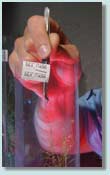 Scientists have inactivated almost three-quarters of all genes in the genome of Arabidopsis thaliana, a species widely used in plant research. The feat, which results in the largest so-called "knockout" gene collection of a complex multi-cellular organism, now allows researchers to study the function of each of those genes individually or together. The findings, published in the August 1 issue of the journal Science, mark an important milestone in the field of plant genomics. Following the release of the Arabidopsis genome sequence in 2000, NSF jump started the next phase of plant genome research, instituting the Arabidopsis 2010 Project to determine the location and function of each and every Arabidopsis gene by the year 2010. Knowing the function of all the genes in this model plant will aide scientists immensely in their work to improve disease resistance, control how quickly or slowly fruit will ripen, and create healthier and improved crops. Scientists have inactivated almost three-quarters of all genes in the genome of Arabidopsis thaliana, a species widely used in plant research. The feat, which results in the largest so-called "knockout" gene collection of a complex multi-cellular organism, now allows researchers to study the function of each of those genes individually or together. The findings, published in the August 1 issue of the journal Science, mark an important milestone in the field of plant genomics. Following the release of the Arabidopsis genome sequence in 2000, NSF jump started the next phase of plant genome research, instituting the Arabidopsis 2010 Project to determine the location and function of each and every Arabidopsis gene by the year 2010. Knowing the function of all the genes in this model plant will aide scientists immensely in their work to improve disease resistance, control how quickly or slowly fruit will ripen, and create healthier and improved crops.
Image courtesy: Kent Schnoeker, The Salk Institute
Read the full story. ... Posted
7/31/03
|
 |
Wireless Network Provides Critical Link in Battle to Control California's Coyote Wildfire
|
 |
| |
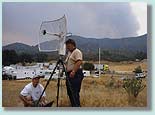 After lightning touched off the Coyote Fire July 16, the California Department of Forestry and Fire Protection (CDF) deployed more than 1,700 firefighters, 10 helicopters and several bulldozers to battle the blaze. To provide Internet communications for the CDF operations camp, researchers from the University of California, San Diego (UCSD), and San Diego State University deployed a high-speed wireless link to the remote site in northeastern San Diego County within hours of a request for help. "The dissemination of information and incident intelligence up and down the command-and-control chain of command is more important than ever," said Jim Garrett, CDF Emergency Command Center chief. "The connectivity provided to CDF for the Coyote Fire was a real-life exercise that clearly demonstrated how valuable and useful the technology provided by HPWREN is to our agency." After lightning touched off the Coyote Fire July 16, the California Department of Forestry and Fire Protection (CDF) deployed more than 1,700 firefighters, 10 helicopters and several bulldozers to battle the blaze. To provide Internet communications for the CDF operations camp, researchers from the University of California, San Diego (UCSD), and San Diego State University deployed a high-speed wireless link to the remote site in northeastern San Diego County within hours of a request for help. "The dissemination of information and incident intelligence up and down the command-and-control chain of command is more important than ever," said Jim Garrett, CDF Emergency Command Center chief. "The connectivity provided to CDF for the Coyote Fire was a real-life exercise that clearly demonstrated how valuable and useful the technology provided by HPWREN is to our agency."
Image courtesy: High Performance Wireless Research and Education Network (HPWREN)
Read the full story. ... Posted
7/28/03
|
 |
Hydrothermal Vent Systems Could Have Persisted for Millions of Years, Incubated Early Life; Video Available
|
 |
| |
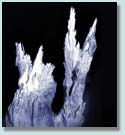 The staying power of sea-floor hydrothermal vent systems like the bizarre Lost City vent field is one reason they also may have been incubators of Earth's earliest life, scientists report in a paper published in the July 25 issue of Science. Discovered just two years ago, Lost City has the tallest vents ever seen-the 18-story-tall vents at that site dwarf most vents elsewhere by at least 100 feet. Water is circulated through the vent field by heat from serpentinization, a chemical reaction between seawater and the mantle rock on which Lost City sits, rather than by heat from volcanic activity or magma, responsible for driving hydrothermal venting at sites scientists have been studying since the early 1970s. If hydrothermal venting can occur without volcanism, it greatly increases the number of locations on the seafloor of early Earth where microbial life could have started. The staying power of sea-floor hydrothermal vent systems like the bizarre Lost City vent field is one reason they also may have been incubators of Earth's earliest life, scientists report in a paper published in the July 25 issue of Science. Discovered just two years ago, Lost City has the tallest vents ever seen-the 18-story-tall vents at that site dwarf most vents elsewhere by at least 100 feet. Water is circulated through the vent field by heat from serpentinization, a chemical reaction between seawater and the mantle rock on which Lost City sits, rather than by heat from volcanic activity or magma, responsible for driving hydrothermal venting at sites scientists have been studying since the early 1970s. If hydrothermal venting can occur without volcanism, it greatly increases the number of locations on the seafloor of early Earth where microbial life could have started.
Image courtesy: NSF, with cooperation from the University of Washington
Read the full story. ... Posted
7/24/03
|
 |
Self-Assembling Devices at the Nanoscale
|
 |
| |
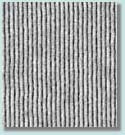 Scientists at the University of Wisconsin's Materials Research Science and Engineering Center (MRSEC) on Nanostructures, Materials, and Interfaces have demonstrated a technique that could one day allow electronic devices to assemble themselves automatically -- giving semiconductor manufacturers a way to mass-produce "nanochips" that have circuit elements only a few molecules across, roughly ten times smaller than the features in current-generation chips. "In terms of storage alone, that could mean a computer with 4,000 gigabytes of memory," says center director Juan de Pablo, a member of the Wisconsin team, which is publishing its results in the July 24 issue of the journal Nature. The Wisconsin MRSEC is one of 27 materials research centers established by the National Science Foundation. Scientists at the University of Wisconsin's Materials Research Science and Engineering Center (MRSEC) on Nanostructures, Materials, and Interfaces have demonstrated a technique that could one day allow electronic devices to assemble themselves automatically -- giving semiconductor manufacturers a way to mass-produce "nanochips" that have circuit elements only a few molecules across, roughly ten times smaller than the features in current-generation chips. "In terms of storage alone, that could mean a computer with 4,000 gigabytes of memory," says center director Juan de Pablo, a member of the Wisconsin team, which is publishing its results in the July 24 issue of the journal Nature. The Wisconsin MRSEC is one of 27 materials research centers established by the National Science Foundation.
Image courtesy: Paul F. Nealey
Read the full story. ... Posted
7/23/03
|
 |
Hawaii Ocean Mixing Experiment Scientists Close in on Puzzle of Ocean Energy
|
 |
| |
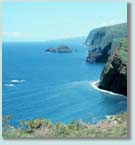 Scientists are closing the gap in deciphering one of the most puzzling aspects of the world's oceans, ocean mixing. These complex motions of seawater that span large-scale phenomena down to tiny, centimeter-sized turbulence serve a key role in redistributing heat throughout the oceans. But a mystery remains in accounting for how these mixing processes unfold. In a research paper published in the July 18 issue of Science, scientists representing six institutions describe ocean mixing in unprecedented detail, capturing intriguing phenomena such as undersea waves that spanned nearly 1,000 feet. Scientists are closing the gap in deciphering one of the most puzzling aspects of the world's oceans, ocean mixing. These complex motions of seawater that span large-scale phenomena down to tiny, centimeter-sized turbulence serve a key role in redistributing heat throughout the oceans. But a mystery remains in accounting for how these mixing processes unfold. In a research paper published in the July 18 issue of Science, scientists representing six institutions describe ocean mixing in unprecedented detail, capturing intriguing phenomena such as undersea waves that spanned nearly 1,000 feet.
Image courtesy: National Oceanic and Atmospheric Administration/Department of Commerce
Read the full story. ... Posted
7/17/03
|
 |
House VA, HUD Appropriators Recommend 6.2 Percent Increase for NSF
|
 |
| |
 On July 15, the House subcommittee with jurisdiction over NSF's annual budget approved legislation that would provide the agency with $5.689 billion for the 2004 fiscal year, which begins on October 1, 2003. The bill, marked up by the House Appropriations Committee's Subcommittee on VA, HUD, and Independent Agencies, represents an increase of 6.2 percent ($329 million) over the level for the current fiscal year. Funding includes: $4.3 billion for research, $192 million for research equipment, and $904 million for education and human resources. The measure now goes to the full House Appropriations Committee for consideration. On July 15, the House subcommittee with jurisdiction over NSF's annual budget approved legislation that would provide the agency with $5.689 billion for the 2004 fiscal year, which begins on October 1, 2003. The bill, marked up by the House Appropriations Committee's Subcommittee on VA, HUD, and Independent Agencies, represents an increase of 6.2 percent ($329 million) over the level for the current fiscal year. Funding includes: $4.3 billion for research, $192 million for research equipment, and $904 million for education and human resources. The measure now goes to the full House Appropriations Committee for consideration.
Image: GettyImages/PhotoDisc
Read the full story. ... Posted
7/16/03
|
 |
Video Available: Scientists Probe Giant Storm Clusters across Midwestern States
|
 |
| |
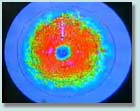 From the air and on the ground, scientists spent this spring and early summer chasing and monitoring some of the world's largest thunderstorm systems, behemoths that can spread hurricane-force wind and torrential rain for hundreds of miles. Using specially equipped airplanes and ground-based units, the researchers traversed the Midwestern U.S. as part of the Bow Echo and Mesoscale Convective Vortex Experiment (BAMEX). The study, which ran through July 6, is expected to provide the clearest picture to date of how such storms wreak havoc and how forecasters can better predict trails of storm damage. Now, video footage is available showing some of the research aircraft and mobile ground-based systems that were part of BAMEX. From the air and on the ground, scientists spent this spring and early summer chasing and monitoring some of the world's largest thunderstorm systems, behemoths that can spread hurricane-force wind and torrential rain for hundreds of miles. Using specially equipped airplanes and ground-based units, the researchers traversed the Midwestern U.S. as part of the Bow Echo and Mesoscale Convective Vortex Experiment (BAMEX). The study, which ran through July 6, is expected to provide the clearest picture to date of how such storms wreak havoc and how forecasters can better predict trails of storm damage. Now, video footage is available showing some of the research aircraft and mobile ground-based systems that were part of BAMEX.
View the video. ... Posted
7/16/03
|
 |
NSF Director Discusses 'Convergent Connections' Between Information Technology and Science and Engineering
|
 |
| |
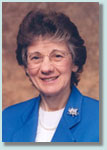 "Our new information and communication technologies have transformed the very conduct of research," NSF Director Rita R. Colwell told the audience at Carnegie Mellon University’s workshop on "Information Technology and Sustainable Development" on June 26, 2003. After noting examples of new IT tools and services that have altered the way scientists and engineers work, she predicted, "Convergent technologies will produce new, even more powerful tools. With the insights drawn from multidisciplinary research, and with a global perspective--for the first time we are launching on a course to chart the design of our biocomplex world, including the dynamics of disease and environment repair." NSF, the World Bank, and the United Nations co-sponsored the workshop. "Our new information and communication technologies have transformed the very conduct of research," NSF Director Rita R. Colwell told the audience at Carnegie Mellon University’s workshop on "Information Technology and Sustainable Development" on June 26, 2003. After noting examples of new IT tools and services that have altered the way scientists and engineers work, she predicted, "Convergent technologies will produce new, even more powerful tools. With the insights drawn from multidisciplinary research, and with a global perspective--for the first time we are launching on a course to chart the design of our biocomplex world, including the dynamics of disease and environment repair." NSF, the World Bank, and the United Nations co-sponsored the workshop.
Read the full speech . ... Posted
7/10/03
|
 |
Scientists Discover Planetary System Similar to Our Own
|
 |
| |
 An international team of scientists has discovered a planet and star that may share the same relationship as Jupiter and our Sun, the closest comparison that researchers have found since they began their search for extra-solar planets nearly a decade ago. By analyzing light spectra collected with the 3.9-meter Anglo-Australian Telescope in Siding Spring, Australia, scientists from the United States, Australia, and Britain made precision measurements of the star HD 70642. The telescope data reveal a wobble in the star's position, an artifact from the gravitational tug of a planet roughly twice the size of Jupiter. The star is similar in size and structure to our Sun. An international team of scientists has discovered a planet and star that may share the same relationship as Jupiter and our Sun, the closest comparison that researchers have found since they began their search for extra-solar planets nearly a decade ago. By analyzing light spectra collected with the 3.9-meter Anglo-Australian Telescope in Siding Spring, Australia, scientists from the United States, Australia, and Britain made precision measurements of the star HD 70642. The telescope data reveal a wobble in the star's position, an artifact from the gravitational tug of a planet roughly twice the size of Jupiter. The star is similar in size and structure to our Sun.
Image courtesy: David A. Hardy, astroart.org Copyright ©Particle Physics and Astronomy Research Council
Read the full story. ... Posted
7/3/03
|
 |
Christopher Columbus Award Winners Announced; Nearly 2,000 Students Entered Nationwide
|
 |
| |
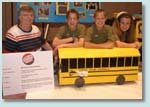 Students from across the country traveled to Walt Disney World recently to compete in the Christopher Columbus Awards, a national competition that challenges middle-school students to develop ideas for positive change in their communities. The top winner -- a group of sixth-graders from Hatfield, PA, near Philadelphia -- developed an idea to mount motion sensors and video cameras on the outside of school buses to deter motorists from passing illegally while the buses are loading or unloading students. They received the $25,000 Columbus Foundation Community grant to help bring their idea to life in school districts across the country. Teams from Bexley, Ohio, Mandeville, Louisiana, and Carlinville, Illinois, were also named winners. Students from across the country traveled to Walt Disney World recently to compete in the Christopher Columbus Awards, a national competition that challenges middle-school students to develop ideas for positive change in their communities. The top winner -- a group of sixth-graders from Hatfield, PA, near Philadelphia -- developed an idea to mount motion sensors and video cameras on the outside of school buses to deter motorists from passing illegally while the buses are loading or unloading students. They received the $25,000 Columbus Foundation Community grant to help bring their idea to life in school districts across the country. Teams from Bexley, Ohio, Mandeville, Louisiana, and Carlinville, Illinois, were also named winners.
Read the full story. ... Posted
7/1/03
|
 Top of Page Top of Page
|
|
|
 |
 |
 |
 |
 |
 |
 |
 |
|
 |
 |
 |
|
|

